Polar Loop 2 Review
Polar Loop 2
Polar's second-gen tracker is a solid update – but not much more
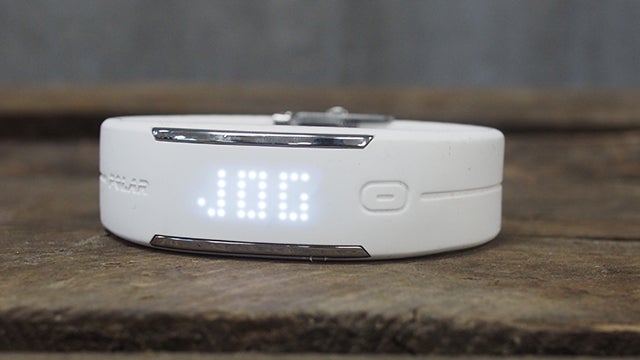
Verdict
Pros
- Light and comfortable to wear
- Useful inactivity alerts
- Easy to setup external heart-rate monitor support
Cons
- Fiddly customising the perfect fit
- Some syncing issues
- Not a very sleek design
Key Specifications
- Review Price: £94.50
- Tracks steps and distance
- Inactivity alerts
- Calculates smart calories
- Automatic sleep tracking
- Smart notifications
- Works with iOS and Android
- Up to eight days' battery life
- Rechargeable 38mAh battery
- Works with Polar H7 heart-rate monitor chest strap
What is the Polar Loop 2?
The Polar Loop 2 is the Finnish company’s second-generation sub-£100 activity tracker. Following years of making sports watches and wireless heart-rate monitors, Polar decided to take on the likes of Fitbit, Jawbone and Misfit with its very own fitness band.
However, if you were hoping for a radical overhaul with the new Loop, think again. The design is near-identical design and uses the same built-in sensors to track activity. There are a few smartwatch-inspired features here as well, and the Loop 2 will play nice with iPhones, Android phones and Windows Phone smartphones.
As an upgrade, the Polar Loop 2 covers the basics. The question is whether this is enough. I’m not entirely convinced.
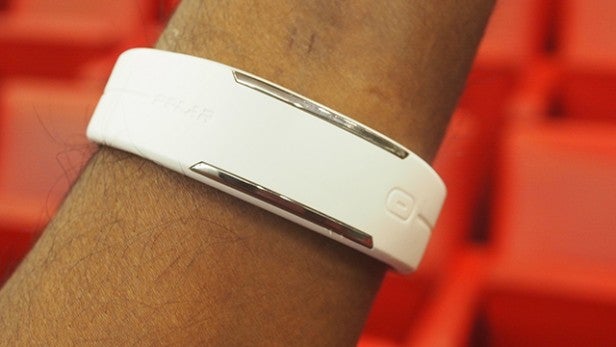
Polar Loop 2 – Design and Features
The Loop 2 is a spitting image of the original Loop. It has the same soft, rubbery silicone wristband and stainless-steel metal buckle to keep it securely around your wrist. Polar also offers a lighter, slimmer band – at only 2g – made from a TPU plastic. Either way, the Loop 2 is nowhere near as sleek as Jawbone’s trackers, and many ways reminds me a lot of the Mio Fuse.
Polar offers the Loop 2 in Sorbet Pink, Powder White or a Swarovski crystal-emblazoned version, which inevitably makes it stand out more than its predecessor. This won’t be a problem is you spend much of your time in gym clothes, but the watch will look out of place if you tend to dress smart on a daily basis.
On the top of the band sit two metal strips, flanking a dot matrix-style display that uses LED lights. The display looks very similar to that on the Nike Fuelband, and so as is the case with that one, suffers from the same visibility issues when you’re trying to view it in bright sunlight.
There’s only a single capacitive button alongside the display, which requires the softest of touches to scroll through the various screens. You can view time, calories burned and step count . There’s an activity bar, too, which works in much the same way as the similar feature on Garmin’s Vivofit trackers. In addition, it will also suggest activities that you could perform to help fill up that activity bar.
Related: 10 Best Fitness Trackers and Activity Trackers
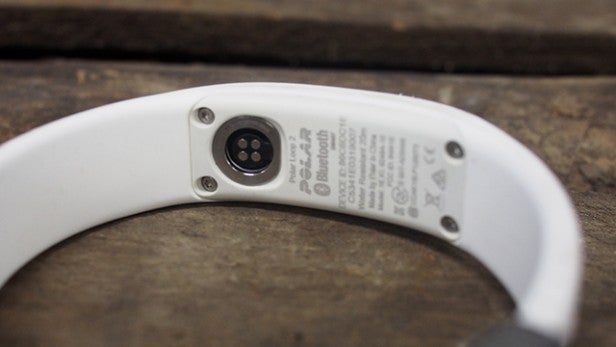
Like the original Loop, the Loop 2 is waterproof, so you can wear it in the shower or in the pool while you swim. Its 2ATM certification means it will survive being submerged in water up to 20m. This can’t compete with the 5ATM certification of the Misfit Shine, but will be fine for most.
Around the back is the Loop 2’s charging port, which annoyingly requires a proprietary charging cable. Unlike Fitbit or Jawbone’s solutions, the cable fits securely in place, so you won’t have to worry about it falling out during charging. Just keep it safe though, since there’s no other way of powering it up.
Despite not being the most attractive of trackers, the Polar Loop 2 is light and comfortable to wear all day and night, and I had no issues with it falling off at any point. However, the first challenge will be to get the right fit, which is easier said than done – it’s one of the fiddliest processes I’ve ever had to go through with a fitness tracker.
Like the original, it involves using a pair of scissors to first cut the bands to make sure it fits loosely around the wrist. There’s a measuring tape tool provided in the instructions pamphlet to ensure you don’t cut off too much. Combine this with lining up the pins and holding the buckle in place, and in total I spent around 30 minutes trying to get it right – swearing numerous times in the process. It’s extremely frustrating.
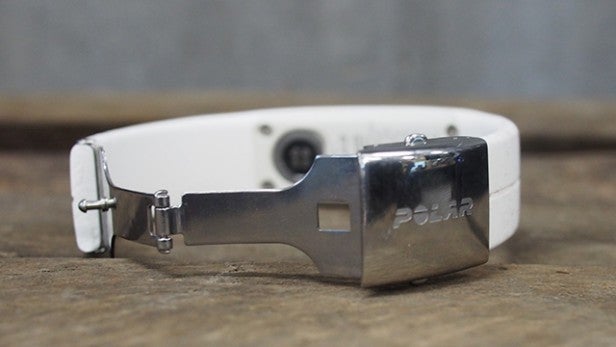
Polar Loop 2 – Polar Flow app
The Loop 2 will give you a glimpse at data, but for a more comprehensive look at your progress you need to access the Polar Flow smartphone and desktop application.
Polar has introduced third-party app support with the Loop 2, so you can integrate your data with fitness apps such as MyFitnessPal. In addition, it will work with Apple Health and Google Fit platforms too.
Polar offers smartphone support for iOS, Android and Windows Phone, but you’ll need to set it up by hooking it up to a computer first – which seems a little archaic in this day and age.
Once you’ve set up a Polar account and synced the Loop 2, you’re free to download the app to sync and view data. I tried out the app on both an iPhone and an Android handset and I’m pleased to report that the experience was pretty consistent across both. Syncing data, however, has its moments.
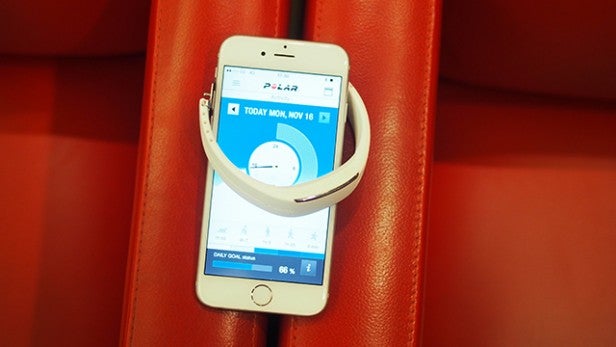
With Bluetooth enabled on the handset, you then tap the button on the Loop 2; now you need to wait for the screen to turn off before the syncing can occur. It sounds easy enough, but there were plenty of occasions where I was left staring at a loading wheel as my phone tried to find my Loop 2.
Once you’re in, you’ll discover a mountain of information; it definitely lacks the more simplistic approach adopted by the likes of Fitbit and Jawbone. It’ll take some time to get to work out what’s useful and what’s not.
The Activity feed is the first thing you’ll see. It lets you view how active you’ve been during the day, and you can breakdown this information either weekly and monthly.
If you’ve been inactive for a long period, you’ll spot an icon on your activity dial that indicates your precise level of laziness. Below this you’ll discover a breakdown of your activity by time. You’ll be able to view how long you’ve been sleeping, sitting, standing, walking and being more energetic such as going for a run. It’s a great way to get a feel of how active you are during the day.
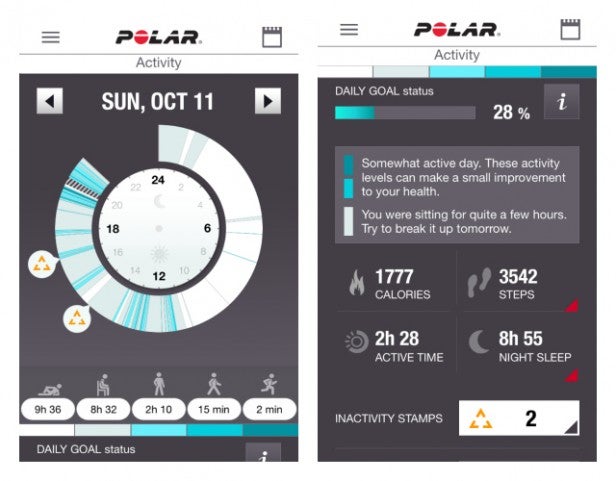
Scroll below and there’s more information on how to reach your daily goal. Anyone fancy 7 hours and 18 minutes of playing darts? There’s also a calorie, step, active time, and sleep breakdown as well. In addition, the app will also leave notes to highlight times that you haven’t been particularly active, or if you’ve been sitting for too long during the day.
Tapping the dropdown menu icon in the top left-hand corner allows you to view a more simplified feed of your daily activity. From here you can set a training diary, view notifications and adjust hardware settings too. You can establish your daily activity goals, which will be broken down into levels and based on how active you are in general.
You can also activate the smartwatch-style features including setting an alarm, smart notifications and set when those notifications are shown during the day and night. These features are pretty basic, though: notifications can be displayed, but with no indication of what they are or anyway to interact with them.
It’s also here that you set up the inactivity alert. This isn’t a new feature – Jawbone has included such as tool for a while now – but nevertheless, the Loop 2’s ability to provide a nudge with its built-in vibration motor when you haven’t been doing much is useful.
Overall, the Polar Flow app provides a good overview of your data, without really drilling deep into the analytical side of things. I think it could be simpler still, stripping away elements that don’t really need to be there. But there’ are some nice touches here.
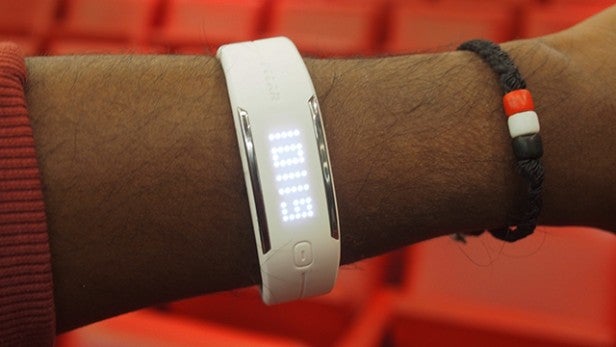
Polar Loop 2 – Performance and Battery Life
I’d like to say that the Polar Loop 2 offers something radically different to its rivals, but this isn’t really what I’ve found in the several weeks I’ve been using it. Tracking accuracy seems fine, but the motivational features just didn’t have the desired effect.
Take the activity bar, for instance. As the bar fills up through the day, it will throw up the various activities you can do to achieve your target goal, along with the time that you need to perform that activity. This is exactly what happens when you sync the Loop 2 with the Flow app, although there’s greater room to offer a few more alternatives. On the band it’s just a little too easy to miss, or even ignore. Perhaps a more purposeful nudge from the vibrating motor frequently throughout the day would have more of an effect.
Daily tracking and sleep monitoring appears to be in line with other wrist trackers. Disappointingly, though, you can’t track elevation. This is where you tend to burn off the majority of calories, especially if climbing the stairs or the escalator is about as energetic as you get. I put it up against the Jawbone UP2 and the Misfit Flash Link for both sleep and step counting and here’s how it compares.
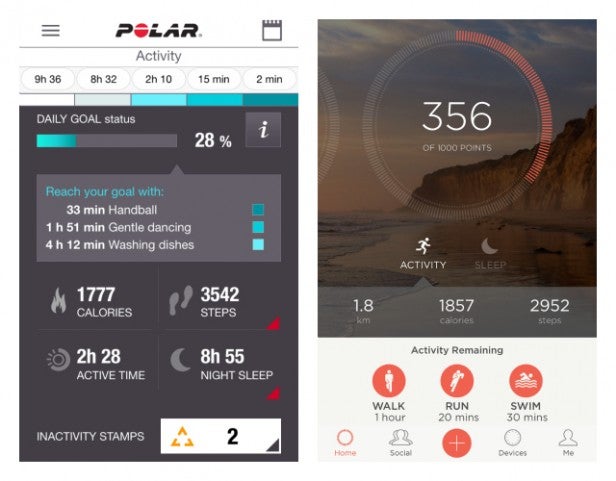
Polar Loop 2 vs Misfit Flash Link
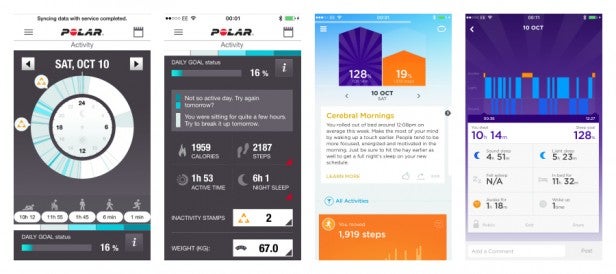
Polar Loop 2 vs Jawbone UP2
Arguably, the Loop 2’s most unique feature is its support for external heart-rate tracking. You’d have to pay £20-30 for a tracker with one built in, but if you already have the chest strap kind with Bluetooth 4.0 support, you can save yourself some money.
To pair, simply put on the chest strap, raise the Loop 2 near to it and tap the button on the tracker. It’s as simple as that – I had no issues syncing the two. Offering real-time readings, it will tell you if you’re in one of two different heart-rate zones: Fit or Fat Burn. If you tend to train in very specific heart-rate zones then it’s likely that you’ll be left underwhelmed by the basic nature of the breakdown.
So what about smartwatch support? Again, it’s all very basic. With such a limited amount of space to play with, there’s no room for the kind of information that would stop you from reaching for your phone. Simply providing a notification of a message or offering caller ID as it scrolls through the display isn’t particularly useful. The silent alarm is a nice addition, though, and much like Fitbit’s version provides a gentle nudge in the morning.
For battery life, Polar claims the Loop 2 should deliver up to eight days thanks to its rechargeable 38mAh battery. This will drop significantly to only three days with the smart notifications support turned on. I found that eight days to be accurate, with a couple days drop-off with the notifications turned on.
These figures are with me wearing the Loop 2 all day and night, with four to five hour-long gym/running sessions a week. So that drop off isn’t as drastic as Polar suggests on its website. But in all honesty, the smartwatch features are so basic that you’d be better off disabling them anyway.
The Loop 2 charges pretty quickly, powering up from flat to 100% in around 30 to 40 minutes.
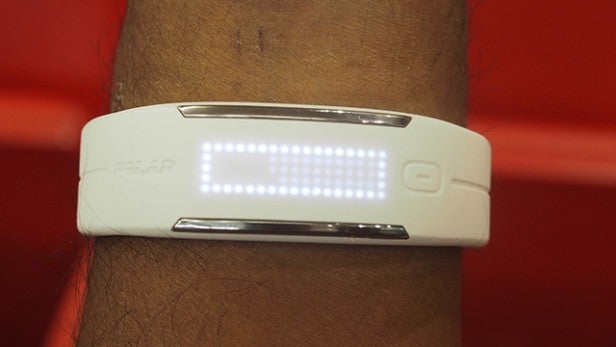
Should I buy the Polar Loop 2?
For Polar Loop owners, I haven’t see enough here to warrant an upgrade. The extra software additions are pretty underwhelming and you’ll still get access to the redesigned Polar Flow app, which is what really stands out. Otherwise, you’re getting the same tracking and wireless heart-rate monitor support wrapped up in a virtually identical design.
If you’re looking for a fitness tracker for less than £100, I’d recommend going for the second-generation Jawbone UP2 – especially if you’re not concerned about the heart-rate monitor support and don’t mind relying on your phone to view progress. It’s sleeker, offers more insightful data and plenty of third-party app support.
The Fitbit Charge HR is a good fit for those who prefer to have support for heart-rate monitoring. It lacks the waterproof design and is a little more expensive, but in pretty much every other way it’s a better option.
The Loop 2 feels very much like an activity tracker that’s striving to be more – but it just doesn’t quite pull it off. Maybe the newly announced Polar A360, which packs Polar’s first optical heart-rate sensor, will be the answer.
Verdict
The Polar Loop 2 is a solid if uninspiring update to the original – I expect more from the next iteration of the Loop.


